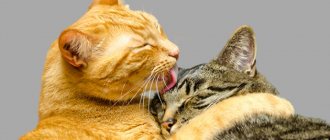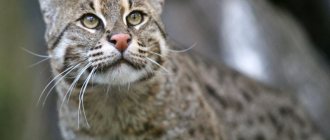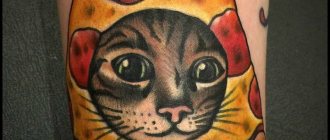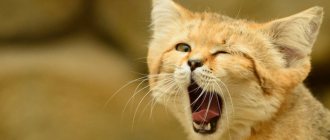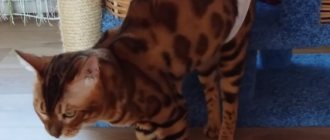History of the discovery of the species
The Latin name for this variety is "Felis nigripes". A clear description was given in 1824. But due to little knowledge of this cat, scientists do not yet know how this species was formed.
Wild African black-footed cat
The distribution range of the black-footed cat is quite narrow. It covers semi-desert and desert areas in Botswana (where the darker subspecies Felis nigripes thomasi is found), Angola, Zimbabwe, South Africa and Namibia.
For your information! There are older descriptions of this species in these countries, but modern zoologists question them.
The black-footed cat has been classified as a vulnerable species since 2002. Zoological scientists monitor its numbers and take measures to preserve the natural habitat of these fauna representatives. Some zoos (for example, in the city of Wuppertal in Germany) specifically breed these miniature predators. They reproduce well in captivity, but you need to create an environment for them that is close to wild habitat conditions.
Note! In 1962, the African black-footed wild cat was successfully crossed with a domestic cat. This was done by Professor P. Leyhausen.
Where to buy a predatory pet
Catteries that breed black-footed cats exist, but they are very rare. This is explained by the difficulties in adapting these wild animals to life in captivity. More often there are hybrids obtained from crossing a black-footed cat with other, more common breeds of cats.
The ant tiger is a rare and exotic breed, and therefore its price is appropriate. The cost of a kitten starts from $10,000. Black-footed cats raised in nurseries adapt faster to new conditions and are less savage. And yet it is imperative to maintain the hunter’s instinct in them.
Interesting Facts
The black-footed cat has an unofficial name - ant tiger. Ant because these small predators often occupy abandoned termite mounds, and the tiger because of its coloring and ferocious disposition. In addition to termite mounds, black-footed cats inhabit rabbit and porcupine burrows left by previous inhabitants.
Tiger cat: description and names of popular breeds
These animals are very active and hardy. During the night of hunting, an ant tiger can travel more than 16 km.
Another interesting fact is that the ant tiger's eyes glow blue or turquoise in the dark, while most cats' eyes glow green or yellow.
Black-footed cats are successful hunters. 60% of their attacks are successful. For comparison: a lion has only 25% of such successful attacks.
The African cat buries excess food and, if it is unable to catch fresh prey, returns to them. But like many desert and steppe animals, it requires very little water. During dry periods, this cat is able to be content only with moisture received with food.
Note! Ant tigers are animals with a loud and not very pleasant voice. At close distances, they communicate with each other using purrs or peculiar sounds reminiscent of gurgling. They can also hiss and growl.
Black-footed cat in the wild
Black-footed cat in the wild
Black-footed cats are endemic to southern Africa. They live in grassland and semi-desert areas, including arid open savanna, where small rodents and ground-roosting birds are abundant. Small predators settle in empty burrows of porcupines, aardvarks, as well as in devastated termite mounds, which is why they received their second unofficial name - ant tiger. Zoologists distinguish two subspecies of black-footed cats:
- Felis nigripes nigripes - found in Namibia,
- Felis nigripes thomasi (darker in color) - found in Botswana.
Little "tigers" are tireless hunters. In one night they can travel up to 16 km in search of small mammals and make one jump for prey every half hour. More than half of these jumps are successful. Black-footed cats hunt at night in all weather conditions, and their survival abilities are admirable. Not every dryland predator can boast that its menu consists of 54 species of different animals and birds. In addition, cats can go without water for a long time, absorbing as much liquid as possible from live food.
The black-footed cat leads a solitary lifestyle. Males occupy a range of up to 15 km2; it often overlaps with the ranges of females, which occupy about 10 km2. The boundaries of territories are marked by both cats and cats. But if cats mainly use marking odors, that is, they rub against objects, leave feces or urine in visible areas, and scratch with their claws, then cats can spray urine up to 12 times per hour. Cats' calls are very loud compared to animals of similar size. At close range, they use quieter sounds: purring, gurgling, hissing or growling if threatened.
Females reach sexual maturity at 8-12 months. The period of sexual activity lasts literally 1-2 days, and fertilization is possible only within a few hours. After courtship and mating, the couple separates. Pregnancy lasts 60-68 days. Then 1-2 half-naked kittens are born, which are completely covered with hair only by 6 weeks, but at 3 weeks they already begin to leave the den. It is interesting that in case of danger they do not return to the house, but scatter and hide in nearby shelters. They sit quietly until their mother calls. At the age of 7-8 weeks, babies try to hunt prey, which is brought to the mother’s den, and already at 3-4 months they begin to get food on their own. Cats can have up to 2 litters during the year.
The black-footed cat is listed in the International Red Book, as well as in Appendix I CITIES. hunting it is prohibited in South Africa and Botswana. In nature, black-footed cats number just over 13,000 individuals, of which about 10,000 are mature.
Video about African black-footed cats:
https://youtu.be/QVXcKmw3qHI
Appearance and features
The black-footed cat is the smallest member of the cat family in Africa. Their sizes are as follows:
- the weight of the female does not exceed 1600 kg, and the length is up to 46 cm;
- The black-footed cat reaches a length of 50 cm and a weight of 2.5 kg.
Toyger (cat): detailed description of the breed
The animal's head is massive (compared to the body). The eyes are large, yellow, and close-set. These little hunters have very good night vision. The ears are round, set high and quite large.
For your information! The physique is dense and athletic. The length of the tail is from 10 to 20 cm. The legs are strong, but short. Thick, hard hair grows on the soles, protecting the pads from the hot sand. The claws are fully retractable.
The color of black-footed cats allows them to camouflage well in steppe and desert conditions. The main color of the coat is yellowish-sand with black spots. Ring black markings are located on the paws and tail. The tip of the tail, paw pads and feet are also black. The ant tiger's nose is pale pink to brownish-red.
The coat is thick and dense. It has excellent thermoregulation and prevents the animal from overheating and hypothermia. This is very valuable, since the difference between day and night temperatures in the desert reaches tens of degrees. For example, in the Kalahari Desert, where these cats are found, it can be 50 °C during the day and 0 °C at night).
The African black-footed cat can withstand 50-degree heat in the desert
Appearance
The black-footed cat is the smallest of all the cats in Africa and is only slightly larger in size than the rusty spotted cat, and therefore takes an honorable second place in the list of the smallest wild cats in the world. The body length of cats is 37-44 cm plus a tail of 16-19 cm. Average weight is 1.9 kg. Cats weigh an average of 1.3 kg, with a maximum of 1.6 kg. Body length usually does not exceed 36 cm plus tail 12.5-17 cm.
The name of these cats should not be misleading. In fact, only the lower part of the legs, which is in contact with the ground, is painted black, not above the metatarsus and wrist. In general, the color is very beautiful: yellow or yellow-brown with dark spots and rosettes along the body. On the upper part of the legs, dark stripes form rings, on the neck there is a “necklace”, and on the muzzle two clear arrows stretch from the eyes back.
Thanks to its coloring, the small cat hides well from enemies and is invisible to its prey. Large eyes are perfectly adapted for hunting at night, and round, mobile ears catch every rustle.
The black-footed cat is quite stocky with large eyes, round ears, a short tail and not too long legs. In addition, black-footed cats have only 6 mammary glands (other cats have light, unpigmented skin, which is not typical for animals with spotted coats.
In addition, black-footed cats have only 6 mammary glands (other cats have light, unpigmented skin, which is not typical for animals with spotted coats.
Character and behavior
The black-footed cat's personality belies its tiny size. These animals are determined and aggressive, capable of attacking (and killing) prey larger than themselves.
How many days does a cat walk: examples for the first time and how long in time
Such cats live only alone and meet only during the breeding season for mating. When a person or a large predator crosses the border of a habitat, ant tigers prefer to hide. But if there is no opportunity to escape, then the African cat will defend itself truly fiercely. A mother protecting a kitten can even drive away a jackal.
Note! The Bushmen have a legend about a black-footed cat that killed a giraffe. However, researchers reasonably doubt this.
The aggression of a small predator is not comparable to its size
Character and habits
The black-footed African cat is extremely unsociable; it hides in a shelter at the slightest rustle, but, driven into a corner, it will desperately defend itself, showing unprecedented courage and tenacity. Females become especially aggressive during the rutting period, pregnancy and raising kittens.
Black-footed cats mostly hunt actively. They do not like to sit in ambush for a long time, and rarely wait for rodents at the hole. They use the darkness of the night and a keen sense of smell, look for traces and get as close to the prey as possible until they can pounce on it. Unlike other cats, they do not like to climb tree branches. The stocky body with a short tail is not adapted for this, but they can vigorously dig through the sand to change the shape of the shelter, making their den more spacious or deeper.
There are legends about the predatory nature of black-footed cats among the Bushman tribes. They say she can kill a giraffe. Of course, this is an exaggeration, which emphasizes her assertiveness and predatory nature. However, she really can try to do the impossible. Eyewitnesses tell how a cat weighing 1.5 kg tracked an ostrich that was sitting in a nest for more than an hour. When the predator was already preparing to jump, the bird stood up and, without even noticing her, disappeared into a cloud of dust.
Can it become a pet?
Despite the fact that the species is protected, its keeping in captivity is not completely prohibited. However, it is very difficult for an ordinary person to create suitable conditions for an ant tiger, because these cats are by no means a decoration for the owner’s sofa. These animals do not become attached to their owner and do not like affection, unlike representatives of many breeds of domestic cats.
Black-footed cat kitten
The ant tiger is Africa's most ferocious predator, nicknamed the "terminator cat"
Our planet is inhabited by a huge variety of amazing living creatures. But perhaps the most unusual among them are the predators from the cat family. Beautiful and noble creatures are distinguished by an abundance of superpowers, which they demonstrate while hunting. Today I would like to talk about the ant tiger. This creature fully justifies its unusual name, because in its predatory habits it really is like a tiger, only small. Well, “ant” was added to its name for its love of settling in abandoned termite mounds and the burrows of some creatures. The size of the black-footed spotted cat is small: only 50 centimeters in length, including the tail. The weight of the animal is less than 2 kilograms. However, because of this, it should not be underestimated; the beast is capable of boasting great achievements in obtaining food. During its nightly walks, the small predator attacks everything that moves and shows signs of life. Due to its fast metabolism, the cat is almost always hungry. While waiting for successful prey, it can walk up to 20 kilometers or sit in ambush for hours.
Despite its pretty appearance and modest size, it is considered the most bloodthirsty predator on African lands. She is capable of attacking a victim several times her weight. The black-footed cat prefers rodents, reptiles, birds and even hares. At the same time, the hunting efficiency of a predatory creature is more than 60%! In one night foray, a cat is capable of attacking 15 animals. Unlike its relatives, it does not know how to climb trees so deftly, but it can do without water for a long time. She gets all the moisture she needs from food. The solitary and secretive lifestyle allows it to still remain practically unstudied.
The sounds made by a cute spotted cat can terrify a person. A loud roar, like a real tiger, gives her considerable self-confidence. Some locals claim that they even saw her boldly attack an ostrich. Due to strong hunting instincts and violent disposition, biologists do not recommend keeping such a creature at home. A small kitten can grow into a dangerous predator that destroys everything around. You can learn more about the South African spotted cat from the video.
Is it hard to believe that such an adorable baby can be such a dangerous and ferocious predator?
Here you can learn about 12 rare wild cats that you probably didn't know about.
Features of care
Black-footed cats require a large and spacious room. In warm latitudes, a mesh enclosure is installed in the open air. To prevent the cat from escaping, the enclosure must have a mesh roof. Fine gravel or sand is poured onto the ground; the ant tiger loves to dig. The thickness of the bulk layer should be 15-20 cm.
The enclosure needs a house where the animal can retire (for example, a hollow log, a cave made of stones, etc.). These items should be placed at different levels, one high enough for the cat to see the surroundings. You definitely need objects that you can climb on. This will provide the animal with the necessary physical activity.
Black-footed cats should sleep for 12-14 hours. Just during their daytime sleep, the enclosure is cleaned, then the miniature predator is the least aggressive.
An examination by a veterinarian twice a year is required.
Important! A specific disease of the black-footed cat, which claims the lives of both adults and cubs, is type AA amyloidosis, i.e. the deposition of a dangerous amyloid protein in the body tissues. The disease is incurable. Currently, the reason for such frequent manifestations of amyloidosis in black-footed cats is not fully understood.
The following can act as a catalyst:
- stress;
- exposure to sunlight (after all, in nature, cats do not come out of their shelter during the day unless absolutely necessary);
- genetic predisposition;
- sedentary lifestyle;
- wrong diet.
Appearance Features
The appearance of the black-footed cat is completely unique and inimitable, all thanks to its atypical and very bright color. The weight of the animal is from 1.6 to 2 kg; individuals with a body weight of about 3 kg are less common. Main characteristics of the animal's appearance:
- The head is large, ideally proportional to the body.
- The eyes are expressive and round in shape. The eyes have the ability to phosphoresce in the dark. This effect is achieved due to the special structure of the retina, which contains a complex vascular network. The degree of visual acuity of the animal at night increases many times, which makes it possible to hunt in pitch darkness.
- The ears are set high, large, and rounded at the ends.
- The physique is dense and stocky, with well-developed and very strong muscles.
- The paws are powerful and strong; the pads have dense pile that protects them from the hot desert sand. The pads themselves are black.
- The tail is of medium length, the tip is always darker than the main color. The color on the tail is black rings.
- Wool – dense and thick, protects well from cold desert nights and helps retain moisture during a hot day.
The color of a black-footed cat can have different variations, ranging from light peach with a yellowish tint to representatives of the breed with a deep dark brown tint. The entire body of the animal is covered with black spots located in a chaotic manner.
The brightest black spots, contrasting with the main color of the coat, are on the tail and limbs. These spots from the tail and paws smoothly transition to the main part of the body.
Nature gave the black-footed cat this color for a reason. This is a kind of protective camouflage that allows the animal to be completely invisible while hunting game.
The color of the fur on the head is usually several shades darker than on the body. The belly, neck and paws on the inside have a lighter coloration, on which the white tips of the fur stand out in contrast.
Diet
In nature, the ant tiger's menu includes:
- larks;
- locusts;
- gophers;
- long-eared mice;
- spiders;
- gerbils;
- termites;
- lizards;
- butterflies;
- fresh and dry grass.
Note! If you're lucky, even a bustard, hare or anteater can become prey.
During the night, a cat eats up to 300 g of food, and sometimes more. Scientists recorded that one small predator ate 450g overnight, which was more than a fifth of its weight. This appetite is due to the high metabolic rate.
It is advisable to minimally disturb the natural biorhythms of the ant tiger. There is no need to transfer the animal's activity to the daytime. Therefore, feeding is carried out at night every 40-50 minutes. in small portions. Most of these desert inhabitants prefer meat along with sinews and cartilage tissue. Chicks and quails are given with their feathers. Fresh meat is supplemented with industrial feed and boiled eggs. To create a proper balanced diet, it is better to consult a veterinarian.
Important! It is not advisable to give fish, since it is not part of the predator’s natural diet.
After a successful hunt, the animal can bury the prey
Reproduction and care of offspring
The mating season for black-footed cats is November-December. To attract a male, the cat emits loud screams and leaves odorous puddles. Feces also serve as a kind of bait for the cat, so they are not buried during the mating season. After mating, the male leaves without taking part in raising the offspring.
Pregnancy lasts longer than that of a domestic cat, at least 10 weeks. Kittens appear in February - early March. The maximum number of cubs in a litter is 3, but most often there are 1 or 2.
The newborn weighs only 60-80 g, but recovers quickly. On the 9th day the kitten will open its eyes, and on the 14th day it will begin to walk. Kittens suckle from their mother only during the day, as she hunts at night.
Note! At 5 weeks, the cubs are already able to eat solid food and climb out of the hole. When they grow up a little, the mother will teach them to hunt, and she does not interfere in the process.
At 4-5 months, black-footed cats are already completely independent, and at 8-9 months they are already sexually mature individuals.
The female feeds the cubs only during the day
Lifespan in the wild
The average lifespan of a black-footed cat is 14-16 years. But this is in captivity and with proper maintenance. In the wild, these small animals rarely live to be 10 years old. Most of them live an average of 7-8 years. The habit of feasting on carrion plays a cruel joke on them. They die from poisons intended for jackals. Some farmers consider them pests and set traps. Ant tigers often eat poisoned locusts.
Note! Another reason for the extinction of the species is the narrowing of its natural habitat due to human activities to expand agricultural land.
In addition, the black-footed cat has many natural enemies. These are pythons, larger representatives of the cat family (for example, caracals), jackals, owls, etc.
Recently, there has been a fashion for stuffed animals of this African cat, so targeted hunting has begun for them.
Can a savage become a pet?
Before you decide to own a black-footed cat at home, you need to familiarize yourself with information about the characteristics of this breed and weigh the pros and cons. The ant tiger is an absolute, wild predator. And even life among people (in a house/apartment) is unlikely to change the habits and habits of an animal. Therefore, the owners of such a pet need to be prepared for a real hurricane to settle in their home.
The black-footed cat, just as it does not like the presence of strangers on its territory in the wild, will not tolerate proximity to other animals in the house. Exceptions may be made in cases where both animals grew up together from a very tender age. However, even in this situation, the possibility cannot be ruled out that in the future the black-footed beast will not begin to show its character and demonstrate who is boss in the house.
A black-footed cat will not be able to live in an apartment. Her life as a pet can only be comfortable in a private house with a large local area. The best option is to build an enclosure outside.
It should contain a large number of ladders and various wooden crossbars necessary for the animal to crawl along them, and bushes - a favorite place for rest. Enclosures should be large enough for the cat to feel comfortable in them and not feel enclosed.
In the cat’s natural habitat – deserts, the ambient temperature ranges from +22° to +27°C. This temperature must also be maintained in the enclosure.
The diet of the domestic black-footed cat includes:
- lean varieties of meat, strictly fresh and high quality;
- chicken offal;
- cartilage and bones, sinewy parts - they contain many nutrients that are essential for the normal development of the animal’s jaw bones;
- dairy products with minimal or medium fat content;
- fresh fish.
To maintain the cat’s natural instincts, it needs to be periodically pampered with live food, introducing small rodents, mice, guinea pigs, and rats into the enclosure. Caring for a black-footed cat as a pet requires regular visits to the veterinarian and vaccinations.
Where to buy an African black-footed cat
Buying a miniature “African” is problematic, and it will cost at least 15 thousand dollars. Therefore, if you want to have a pet with a wild appearance, it is better to pay attention to different breeds of domestic cats. The most similar to the ant tiger are Bengal cats. Bengals also have a difficult character, but they are still adapted to living next to humans.
The black-footed cat is endemic to Africa. Because of its cute appearance, many people want to get this animal. However, ant tigers are too difficult to care for for the average person, so experts recommend choosing less aggressive pets.
Mystery of nature – Black-footed cat
Our Internet resource increasingly began to turn to our four-legged friends who fell into the clutches of extinction. This time we caught our eye on a very mysterious person, about whom little is known - a black-footed cat. This type of cat lives only in a few places: Namibia, South Africa and other countries. This is one of the most mysterious and little-studied representatives of the carnivorous family. So, let's study this type of cat in a little more detail.
Black-footed cat or "ant tiger"
- Habitats: Namibia, South Africa, partly Angola and Zimbabwe
- Body length – no more than 50 cm (females – no more than 40).
- Tail length is from 8 to 20 cm.
- Food: black bustard, hare and many other animals (also carrion)
- Lifestyle - secluded
The black-footed cat is also called by another name - “ant tiger”. This is due to the fact that these cats prefer to settle in devastated termite mounds, burrows of aardvarks, striders or porcupines. Black-footed cats are tireless hunters. In one night, they travel about sixteen kilometers in search of prey - small mammals, especially gerbils and shrews, as well as birds, insects and reptiles. Every half hour, the black-footed cat makes one jump for prey, and more than sixty percent of these jumps have a positive result.
Night hunters
At first glance, they are small, but still predators, using their unusual protective coloring, which fits perfectly with the dark time of day. All this helps the cat hide from its enemies and remain unnoticed by its prey.
Also, do not forget about their rather large ears, which have taken on a rounded shape - this helps them catch the slightest sounds. Plus, in addition to all this, the black-footed cat received a vascular layer located behind the retina, which serves as a reflector (night vision). At night, the blackfoot's eyes glow blue.
So let's get to the hunt. Despite their small size, black-footed cats manage to hunt the black bustard and even the hare and much more (incredibly, its diet includes about 54 species of different animals). Its tenacious claws are unlikely to let go of its prey if it is caught in them.
The best time for hunting is at night.
Black-footed cats can search for their prey all night and despite various weather conditions. Nature has decreed that they have to survive simply in unrealistic situations and it’s simply amazing! Like any desert animal, black-footed cats can go without water for long periods of time, obtaining it exclusively from the food they ingest. It is curious that black-footed cats are very thrifty animals. When their food is abundant, they bury it in their hiding places (something like a squirrel), after which, if necessary, they return to them.
Offspring
It should be noted that black-footed cats lead a solitary lifestyle, except during mating season.
As soon as the process has passed, the male and female immediately separate. The female raises the cubs herself. Pregnancy of a black-footed cat lasts 63-68 days. Usually 1-2 pinkish, half-naked kittens are born. Kittens are completely covered with hair by six weeks. At three weeks, the kittens already leave the den and explore the surrounding areas. When in danger, instead of running back to the den, the kittens scatter across the desert, hide in the nearest shelter and freeze until their mother calls them.
Interesting Facts
I would like to tell you one of the legends about the black-footed cat, and there are quite a lot of them. Some Bushmen tribes believe that such a cat can even kill a giraffe. Of course, one can hardly believe this, but their aggressive nature begins to manifest itself in early childhood. According to some, there was a case when a one and a half kilogram cat tracked an ostrich weighing eighty kilograms sitting on a nest for just over an hour. When the cat was already preparing to jump, the ostrich managed to escape.
As I said just above, the female raises her offspring alone.
And education happens in a rather interesting way. When the kittens are a little older (about 5 weeks), the mother begins to bring live prey to them to teach the kittens how to hunt. This can hardly be called an interesting fact, but the extinction of these animals in the wild is not due to targeted hunting, which is not carried out on them, but due to the fact that black-footed cats often die from animal poisons.
Important
The black-footed cat is listed in the International Red Book and the CITES Convention. Good news, in 2011, at the Endangered Species Research Center (New Orleans), very beautiful black-footed cat kittens were born, and this is truly a unique case. It should be noted that the black-footed cat is one of the smallest wild animals of the cat family

